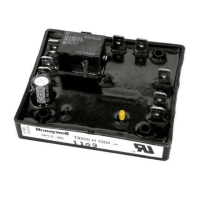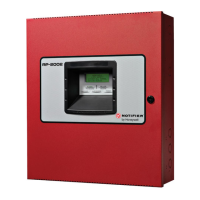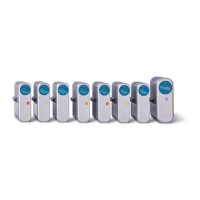Honeywell
transition from arm to
MAINTENANCE
MANUAL
GULFSTREAMIV
capture.
When
in VASEL. the bracket
altitude will be either the preselected altitude or the
altitude constraint, whichever has the smallest altitude error.
When the desired altitude is reached, the ASEL VASEL
CAP mode
is automatically cancelled, and
ALT or VALT hold mode is
automatically selected.
The ALT hold mode is annunciated on the PFD by a green ALT.
The VALT hold mode is annunciated on the PFD by a green VALT.
The ALT or VALT hold mode will be dropped following pitch wheel
movement.
During the three phases (ASEL or VASEL ARM, ASEL or VASEL CAP,
ALT
or VALT HOLD), a GS capture will override the altitude
mode.
If the selected DADC
is not valid, none of the three altitude
modes (ASEL or VASEL ARM, ASEL or VASEL CAP, ALT or VALT HOLD)
can be initiated or continued.
In the FZ-820 Flight Guidance Computer, actual barometric
altitude is compared against preselected altitude or an
altitude constraint.
The altitude signals are provided by the
AZ-81O Digital Air Data Computer and/or the NZ-920 Navigation
Computer through the ASCB.
The resultant altitude error
commands a changing altitude rate from a lookup table in the
FZ-820. The lookup table is a predetermined software program.
Commanded altitude rate is then compared against actual
altitude rate to determine the altitude capture point.
For the
capture detector to trip the following must be true:
● Selected DADC valid.
. ASEL or VASEL mode is armed.
● The ALT set knob is not being turned (SLEW).
● The pitch wheel is not in motion (PW MOTION).
In
the capture detector, if commanded altitude rate is greater
than actual altitude rate, the detector does not trip. When
commanded altitude rate is less than actual altitude rate, the
detector trips and the aircraft will now initiate a flare
maneuver to capture the desired altitude. The capture point
is a nonlinear function dependent on commanded altitude rate.
As an example, with a commanded altitude rate of 24 ft/sec
(1440 ft/min), the capture point is 231 feet from the selected
altitude. With a commanded altitude rate of 100 ft/sec
(6000 ft/min), the capture point will be about 3000 feet from
the selected altitude.
After mode capture, the altitude error signal is run through
the flare computation circuit and G limiter before being summed
with washed out pitch attitude.
The flare computation circuit
is designed to gain adjust the altitude error signal to provide
a constant vertical acceleration capture of the selected
22-14-00
Page 298.116
Apr 15/93
USe or disclosure of information on this page is subject to the restrictions on the title page of this document.

